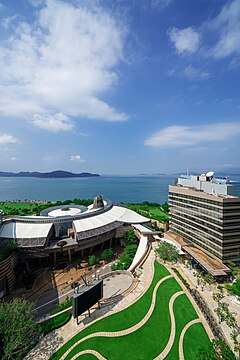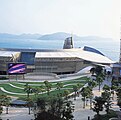Cyberport
| Hong Kong Cyberport | |
|---|---|
數碼港 | |
 | |
 Hong Kong Cyberport | |
 | |
| General information | |
| Status | Complete |
| Location | Cyberport Road, Telegraph Bay, Hong Kong |
| Coordinates | 22°15′42.5″N 114°7′48.77″E / 22.261806°N 114.1302139°ECoordinates: 22°15′42.5″N 114°7′48.77″E / 22.261806°N 114.1302139°E |
| Owner | Hong Kong SAR Government |
| Management | Hong Kong Cyberport Management Company Limited |
| Design and construction | |
| Architect | Wong Tung & Partners Limited |
| Website | |
| cyberport | |
| Cyberport | |||
|---|---|---|---|
| Traditional Chinese | 數碼港 | ||
| |||








Cyberport is a business park in Hong Kong consisting of four office buildings, a hotel, and a retail entertainment complex. It describes itself as a digital technology community with over 1,650 digital and technology companies, including established enterprises such as Microsoft, Lenovo, and ZhongAn, and homegrown companies such as Gogovan, Klook, SleekFlow, GRWTH and Bowtie. Cyberport is managed by Hong Kong Cyberport Management Company Limited,[1] which is wholly owned by the Hong Kong SAR Government.
In operation since 2004, Cyberport focuses on fintech, smart living, digital entertainment and esports, AI and big data, blockchain, and cybersecurity.[2] Cyberport is currently home to the largest Fintech community in Hong Kong with more than 350 Fintech companies. Bowtie, a member of the Cyberport community, was authorised by the Hong Kong Insurance Authority to become Hong Kong's first virtual insurer under the Fast Track system in November 2018. Zhong An and WeLab, who are also members of Cyberport, were two of the initial eight financial institutions and firms to be granted a virtual bank license.[3]
To promote the development of esports in Hong Kong, Cyberport launched the opening of Hong Kong's largest professional-grade esports venue on 16 July 2019 located in the Cyberport Arcade.[4] It also launched the Esports Industry Facilitation Scheme and the Esports Internship Scheme. The former offers cash grants to support industry activities, while the latter provides a cash subsidy for internships in the esports industry.
As of September 2019, Cyberport Incubation Program had incubated and funded over 600 technology start-ups companies since its inception in 2005.[5] The HK$200 million Cyberport Macro Fund,[6] which was announced in 2016 to support local start-ups after seed stage but generally before or around Series A stage of funding, has, as of October 2019, invested in 14 start-ups totalling about HK$106 million.[7]
Cyberport currently comprises four phases, providing a total of 119,000 square metres of office space. The occupancy rate of Cyberport's office reached 97% in the 4th quarter of 2018. The number of applications for the “Cyberport Incubation Programme” has substantially increased from less than 100 per year before 2011 to over 600 per year in recent years.[8]
The Cyberport project has courted controversy since its inception because of the government's bypassing the open-tender process in awarding the project to real estate developer Richard Li Tzar-Kai, and also because of its reliance on "ancillary residential" revenue.[9]
Project background[]
In March 1999, the Hong Kong government announced its intention to develop a "Cyberport", to help local businesses capitalise on the rapid growth of the Internet. The government called it a development where information technology and multimedia would be nurtured so that future demands of these industries could be met. According to the press release by the Commerce and Economic Development Bureau, only one-third of the site would be residential, the sale of which would help finance the Cyberport development.[10] The Cyberport is billed as home to an incubator for ICT startups, providing office space, financial aid, training, micro fund and network access to the investment community.
The Hong Kong government inked a partnership deal with the Pacific Century Group (PCG) to develop a 26-hectare (64-acre) site with open sea view at Telegraph Bay in Pok Fu Lam, Hong Kong Island, at a total cost of HK$13 billion. It was announced as part of the 1999 budget by then-Financial Secretary Donald Tsang. It was also hoped that this development would help the HKSAR's economy rebound after the 1997 Asian financial crisis, and bring a "strategic cluster of information technology and services companies situated in a world-class setting".[10] The "strategic telecommunication node" was due to be formed due to its close proximity to the proposed "Teleport" in Chung Hom Kok.[10] Touted benefits include "a range of shared facilities for tenants, including a multimedia-based network, telecommunication links, media laboratory, cyber library and other information technology and services support facilities. There will also be educational, entertainment and recreational facilities related to information technology and services for local visitors and tourists".[10]
As part of the deal, PCG would construct a 92,000-square-metre (990,000 sq ft) office complex with a 28,000-square-metre (300,000 sq ft) shopping mall and a 173-room hotel that would be put out to management. Title to these properties would be transferred to the government at zero cost, while PCG received land for 420,000 square metres (4,500,000 sq ft) of residential housing in exchange, and would reap 64.5 percent of the profits from their sale.[11]
The construction of the Cyberport portion consisting of four office buildings, The Arcade and Le Meridien Cyberport Hotel, was completed in phases between 2002 and 2004. The residential developments consist of approximately 2,800 units or houses was completed in phases between 2004 and 2008.
Controversy[]
Awarding the project without formal open tender[]
The government's decision in granting the project to Pacific Century Group (PCG) controlled by Richard Li, son of Hong Kong's wealthiest man Li Ka-shing, to develop the site generated much controversy.[12][13] Awarding the project to PCG without a formal open tender attracted criticism for lack of transparency; other interested developers complained of being sidelined.[13][14] Three private and wholly owned companies, namely, Hong Kong Cyberport Development Holdings Limited, Hong Kong Cyberport Management Company Limited and Hong Kong Cyberport (Ancillary Development) Limited (collectively referred to as the "Cyberport companies") were set up under the Financial Secretary Incorporated (FSI) to oversee implementation of the project. The project was criticised as unnecessary government intervention in the real estate sector.
Residential project disguised as tech hub[]
According to critics, Cyberport was a residential project in disguise, as it arguably failed in its mission to become a high-technology hub for the city.[15][16] Eurasia Review suggested that the government land was injected into the project below value. The overall rationale of the project has been questioned by its critics, as details have emerged about the planning and budgeting for the project that indicate that 75% of the area developed is residential, and that office space for the technology companies was only be about 17% of the total. Also the "shared facilities" made up only part of a small 18,000-square-metre (190,000 sq ft) block which includes houses and apartments.[15]
Low occupancy of rental office towers[]
The project had the reputation of a "ghost town", as the government-owned portion suffered low occupancy.[13][9] Fifteen companies signed letters of intent with the developer, including Hewlett-Packard, IBM, Microsoft and Yahoo, but only three moved in at the initial opening, due to a technology slump.[17] The government rejected accusations of favouritism, arguing that PCG's presence as an anchor tenant would be a marketing plus to prestigious international technology companies. In addition, tendering was bypassed ostensibly to shorten the sensitive time frame to bring forward the economic benefits of the project.[18] PCG later hived off the residential property interests into a shell company separate from the telecoms operation so that the shell company would receive the residential housing sales revenues; it was also accorded right of first refusal to redevelop sites of 60 existing telephone exchanges of PCCW, the telecoms operator.[11][16] In October 2004, David Webb cited lack of transparency in the government's business dealings and demanded audited financial accounts and directors' reports for three companies related to the project to be released under the non-statutory Code on Access to Information.[19]
Housing[]


| Bel-Air | |||
|---|---|---|---|
| Traditional Chinese | 貝沙灣 | ||
| |||
Bel-Air is a luxury residential development in Cyberport. The development is split into 6 phases; phase 1 and 2 are referred to as Residence Bel-Air and Phase 3 is referred to as Bel-Air on the Peak. Phase 1 and 2 each have a clubhouse and 7 blocks that are about 48 floors tall. Floor 40 and above are flats that have the area of two flats combined into one, creating over 3,200 square feet (300 m2). All of which feature sky gardens with ocean views. Enumeration of "Block 4" and all 4th floors of each block has been avoided for superstitious reasons. However, the management company neglected to omit 4 when naming the construction phases.
Each floor of "Bel-Air on the Peak" has 2 or 3 apartments, 2 larger units, 'A' and 'C' and a smaller 2-bedroom unit 'B'. The clubhouse of "Bel-Air on the Peak" is significantly newer with more artistic features.[citation needed] They maintain an indoor pool, gym, restaurant, snooker room and children's game room.
Bel-Air has 2 clubhouses: the Bay Wing and Peak Wing. They feature a spa, indoor and outdoor swimming pools, game's room, gym, children's playroom, restaurant and personal cinema. Each floor of the "Residence Bel-Air" has 2 flats with 3 bedrooms, 1 kitchen and a balcony. Additionally, there are single-family homes near "Residence Bel-Air".
Gallery[]

Entrance

Aerial view

Cyberport 2

Cyberport 3

The Podium and Arcade

Network Operations Centre of Cyberport
See also[]
- Hong Kong Free Press – a digital news outlet operating from Cyberport
- Jolla – R&D centre located in Cyberport
- Sailfish Alliance – Cyberport Hong Kong is one of the partners in the Sailfish Alliance.
References[]
- ^ https://www.cyberport.hk/en/about_cyberport/about_overview
- ^ https://www.cyberport.hk/files/annual_report/2018/Full_PDF/2018-19_Cyberport_AR_Full_PDF_ENG.pdf
- ^ "Boost fintech or risk losing out to rivals, Cyberport boss warns". 29 April 2019.
- ^ http://www.thestandard.com.hk/section-news.php?id=209683&story_id=50041163&con_type=1&d_str=20190717&sid=
- ^ https://www.legco.gov.hk/yr18-19/english/panels/itb/papers/itb20190114cb1-426-3-e.pdf
- ^ "Cyberport launches new fund to develop start-up ecosystem".
- ^ https://www.cyberport.hk/files/5dc4d2f7baae1354342550/20191105_press_eng_v2.pdf
- ^ https://www.districtcouncils.gov.hk/south/doc/2016_2019/en/committee_meetings_doc/DDHC/16036/DDHC_2019_11_EN.pdf
- ^ Jump up to: a b "Cyberport cyber factor stalled". South China Morning Post. 8 January 2005. Retrieved 12 July 2020.
- ^ Jump up to: a b c d "$13 billion Cyberport project announced". Commerce and Economic Development Bureau (Communications and Technology Branch). 3 March 1999.
- ^ Jump up to: a b "After Selling PCCW, in which industry will RICHARD LI find his future?". Asia Sentinel.
- ^ "ASIA-PACIFIC – Hong Kong signs Cyberport deal". BBC.
- ^ Jump up to: a b c Truong, Alice (8 December 2010). "Cyberport's Chief Executive on Web 3.0 and Technology in Hong Kong". The Wall Street Journal.
- ^ Ko, Eric (21 March 1999). "Cyberport critics get stake hint". The Standard. Hong Kong. Archived from the original on 22 November 2007. Retrieved 11 January 2007.
- ^ Jump up to: a b "Hong Kong: Revelations In SHK Bribery Case; Collusion Between Politicians And Property Tycoons – OpEd". Eurasia Review. 16 July 2012.
- ^ Jump up to: a b Andrew Coffey (12 May 2004). "Cyberport tech park still has doubters". The Age.
- ^ "Multinationals back away from Hong Kong's IT park". Taipei Times. 5 April 2002.
- ^ "Secret deal on Cyberport dismissed". info.gov.hk. 16 March 1999.
- ^ "Cyberport Secrets". webb-site.com.
External links[]
| Wikimedia Commons has media related to Cyberport. |
- Internet in Hong Kong
- Office buildings in Hong Kong
- Science and technology in Hong Kong
- Business parks
- Telegraph Bay
- Hongkong Land
- Private housing estates in Hong Kong
- Restricted areas of Hong Kong red public minibus
- Intelligent Community Forum
- Esports venues in China






